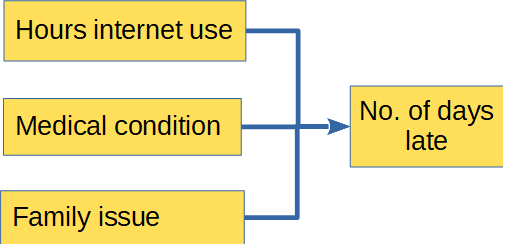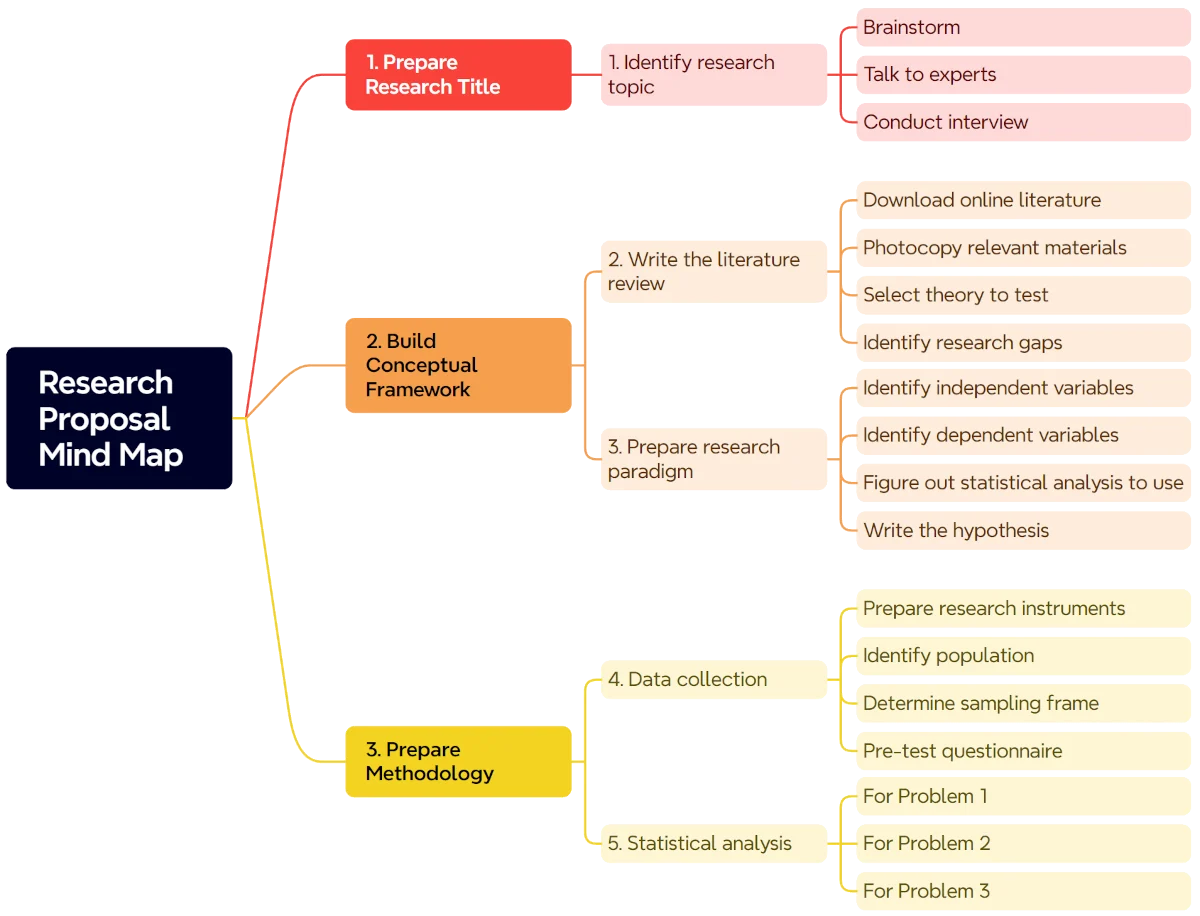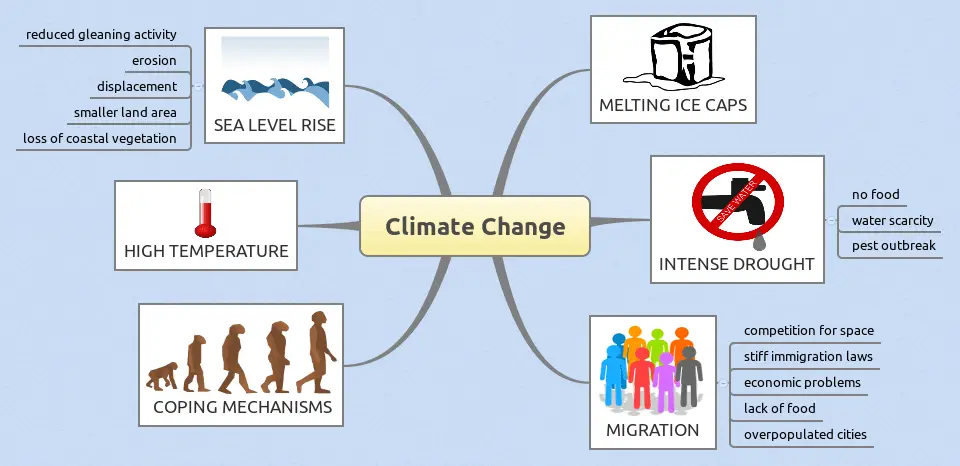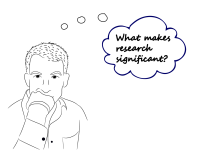
Table of Contents
Introduction
Developing a strong conceptual framework or research proposal often overwhelms students and researchers. The difficulty usually arises from unfamiliarity with the topic and the challenge of identifying the knowledge gap. A powerful tool that can simplify this process is the mind map. Beyond research, mind mapping is also a practical method for organizing goals, aligning tasks, and clarifying life’s priorities.
This article explains what a mind map is, how to create one, and why it can enhance both your academic work and personal decision-making.
What is a Mind Map?
A mind map is a visual representation of ideas arranged around a central concept. It encourages non-linear thinking, making it easier to see relationships, generate insights, and retain information.
A mind map is a visual representation of ideas arranged around a central concept. It encourages non-linear thinking, making it easier to see relationships, generate insights, and retain information.
Key features include:
- Central Idea – the main theme or research problem.
- Branches – connecting lines that represent related ideas or subtopics.
- Keywords and Images – concise words or visuals that trigger memory.
- Colors and Codes – used to categorize and make the map engaging.
Mind mapping is widely used in education, research, business, and personal goal setting.
Benefits of Mind Mapping: 5 Mind Map Examples
1. Identifying Knowledge Gaps
When reviewing literature, a mind map helps you see what has already been studied and what remains unexplored—the knowledge gaps. By placing the dependent variable at the center and branching out to possible factors (independent variables), you can quickly spot under-researched areas.
Example: A teacher researching student tardiness can map out known predictors (internet use, sleep quality, distance from school, parental involvement). The visualization highlights which variables were studied extensively and which remain unclear.

2. Building a Conceptual Framework from a Mind Map
A mind map can serve as the foundation for a conceptual framework. Once you identify relationships among variables, you can convert them into a research paradigm, which is a structured diagram that shows how the independent variables (predictors) influence the dependent variable (outcome).
A research paradigm is essentially the “roadmap” of your study—it visually presents the cause-and-effect relationships or associations that your research will investigate.
Here’s how the transition works step by step:
- Start with the mind map – Place your central topic (often the dependent variable) in the center. For example, student tardiness.
- Branch out possible factors – Add related variables, such as internet use, sleep quality, distance from school, and parental guidance.
- Cluster variables into categories – For example, some may be personal factors (internet use, sleep habits), while others are environmental factors (distance, school rules).
- Identify relationships – Use arrows or connecting lines to show which factors are likely to influence tardiness. For instance, internet use → poor sleep → tardiness.
- Convert to a paradigm – From the mind map, redraw only the variables and relationships most relevant to your research. Independent variables are placed on the left, the dependent variable on the right, with arrows showing hypothesized influences.
Example: If parents report that excessive internet use causes children to sleep late and arrive tardy, you can integrate internet use as an independent variable in your conceptual framework, alongside other significant predictors.
- Independent Variables: Internet use, parental monitoring, distance from school
- Dependent Variable: Student tardiness

The mind map helps you brainstorm and consider multiple angles, but the paradigm filters and organizes these into a clear framework that can guide your hypotheses, methods, and analysis.
3. Preparing a Research Proposal
Mind mapping streamlines proposal writing by breaking the task into clear steps:
- Identify your main goal – e.g., Prepare Research Proposal.
- List major activities – create a research title, build a conceptual framework, and draft the methodology.
- Specify detailed actions – brainstorm, gather literature, select a theory, prepare instruments, and plan analysis.

Using free tools like XMind, Mindmeister, or Coggle, or even a simple sheet of paper, you can visualize tasks, set deadlines, and monitor progress.
4. Mind Mapping Variables to Help Identify New Angles for Another Study
Mapping variables such as adaptation strategies, community practices, and socio-economic factors allows researchers to visualize how these elements interact within a system. By laying them out in a mind map, you can spot connections, overlaps, and gaps that may not be obvious in linear notes.
For example, in a study on climate change adaptation, you might:
- Start with the central theme – Community Resilience to Climate Change.
- Branch out adaptation strategies – e.g., crop diversification, rainwater harvesting, coastal mangrove reforestation.
- Add community practices – e.g., traditional knowledge sharing, cooperative labor, indigenous rituals linked to resource management.
- Incorporate socio-economic factors – e.g., income level, access to education, government subsidies.
When all these are mapped together, patterns emerge. For instance, you may notice that communities with stronger traditional practices but lower socio-economic resources still manage effective adaptation because of shared labor. This opens a new angle of study: How cultural practices offset economic limitations in resilience-building.
Similarly, mapping might reveal that households with higher income adopt technology-driven adaptation (like irrigation pumps), while lower-income households rely on community-based practices. This contrast could spark a comparative study of the effectiveness of different adaptation pathways.
In other words, the mind map doesn’t just organize known variables—it becomes a tool to generate new research questions by showing relationships, contradictions, and underexplored connections.

5. Enhancing Creativity in Literature Review
Mind maps encourage free-flow brainstorming because they do not demand immediate structure, hierarchy, or evaluation of ideas. When you sit down to write a research proposal or conceptual framework, it’s easy to fall into analysis paralysis—spending too much time trying to categorize or critique every idea before it’s even written down. This slows progress and often causes creative blocks.
With mind mapping, you simply let ideas flow and place them on the diagram as they come, without worrying about whether they are strong, weak, relevant, or even practical at first glance. The focus is on capturing possibilities, rather than filtering them prematurely.
This process is especially helpful because:
- Hidden variables surface – You may jot down a factor you wouldn’t have considered in a linear outline, such as social media influence or peer expectations in a study on academic performance.
- Unexpected connections emerge – By seeing everything visually, you might notice that two seemingly unrelated ideas (like “study habits” and “commuting time”) actually interact in meaningful ways.
- Reduced self-censorship – When ideas are captured without judgment, researchers avoid discarding insights that could later be refined into strong hypotheses.
- Encourages divergent thinking – The branching nature of a mind map pushes the brain to explore in multiple directions, fostering creativity alongside logical reasoning.
In short, a mind map creates a safe space for raw ideas, which can later be refined, organized, and tested. This is why many researchers use mind mapping at the early stages of study design, before moving on to more rigid structures like research paradigms and frameworks.
Tips for effective mind mapping in research
Here are tips for effective mind mapping in research:
- Think freely. Don’t over-evaluate connections while drafting.
- Be conscious of time. Set a time limit per branch.
- Make it easy to organize. Use colors, symbols, or drawings for better recall.
- Be a wide reader. Read widely so you have more concepts to map.
Beyond Research: Mind Mapping for Goals and Teaching
Mind mapping is not just for academics. It can also help:
- Students – clarify learning outcomes by aligning lessons with essential competencies.
- Teachers – design modules that focus on higher-order thinking skills (HOTS) such as analyzing, creating, and evaluating.
- Individuals – reflect on life goals, especially during uncertain times (e.g., COVID-19 pandemic).
By mapping your desires and priorities, you can visually see whether your daily activities align with what you truly value.

Other Example Applications of Mind Maps
- Graduate School Outcomes. Professors can use fishbone diagrams (a form of mind map) to define expected outcomes, like developing the capacity to perform economic valuation studies.
- Personal Goals. Mapping helps individuals decide whether they are prioritizing relationships, careers, or personal growth.
Conclusion
A mind map is more than a colorful diagram—it is a powerful thinking tool. Whether you are identifying a research gap, preparing a conceptual framework, writing a proposal, or clarifying personal goals, mind mapping provides structure and creativity at the same time.
Try starting with a central question or goal, branch out your ideas, and let the connections reveal new insights. With consistent practice, you’ll find that your research becomes more systematic, and your personal decision-making clearer.
References
WorldFish (2013). Economic analysis of climate change adaptation strategies in selected coastal areas in Indonesia, Philippines and Vietnam.
Gemmill, E. L., & Peterson, M. (2006). Technology use among college students: implications for student affairs professionals. Retrieved October 20, 2019, from https://tinyurl.com/y2cks6dk
Mizan, S. S., & Shendell, D. G. (2011). Absence, extended absence, and repeat tardiness related to asthma status among elementary school children. Retrieved October 20, 2019, from https://tinyurl.com/y6rfl5l
Frequently Asked Questions About Mind Mapping
1. What is a mind map?
A mind map is a visual diagram that organizes ideas around a central concept. It uses branches, keywords, and sometimes images to show relationships and encourage creative thinking.
2. How does mind mapping help in research?
Mind mapping helps identify knowledge gaps, build conceptual frameworks, and prepare research proposals. It allows researchers to visualize connections among variables and organize literature more systematically.
3. Can a mind map be used for personal goals?
Yes. Mind mapping is useful not only in academic research but also in personal goal setting. By mapping priorities and desired outcomes, you can clarify what matters most and plan concrete steps to achieve it.
4. What tools can I use to create a mind map?
You can use free mind mapping tools like XMind, MindMeister, or even a blank sheet of paper with colored pens. Digital tools offer templates, export options, and collaboration features.
5. What are tips for effective mind mapping?
- Don’t overthink connections when brainstorming.
- Use colors and images for better recall.
- Set time limits to keep ideas flowing.
- Keep the central idea clear and concise.
- Expand branches as your understanding grows.
6. Can a mind map improve a conceptual framework?
Yes. By mapping variables and their relationships, you can convert a mind map into a research paradigm that forms the basis of a conceptual framework.
7. Is mind mapping suitable for students?
Absolutely. Students can use mind maps to summarize lessons, prepare research projects, and clarify learning outcomes. Teachers can also use them to design modules and highlight higher-order thinking skills.




